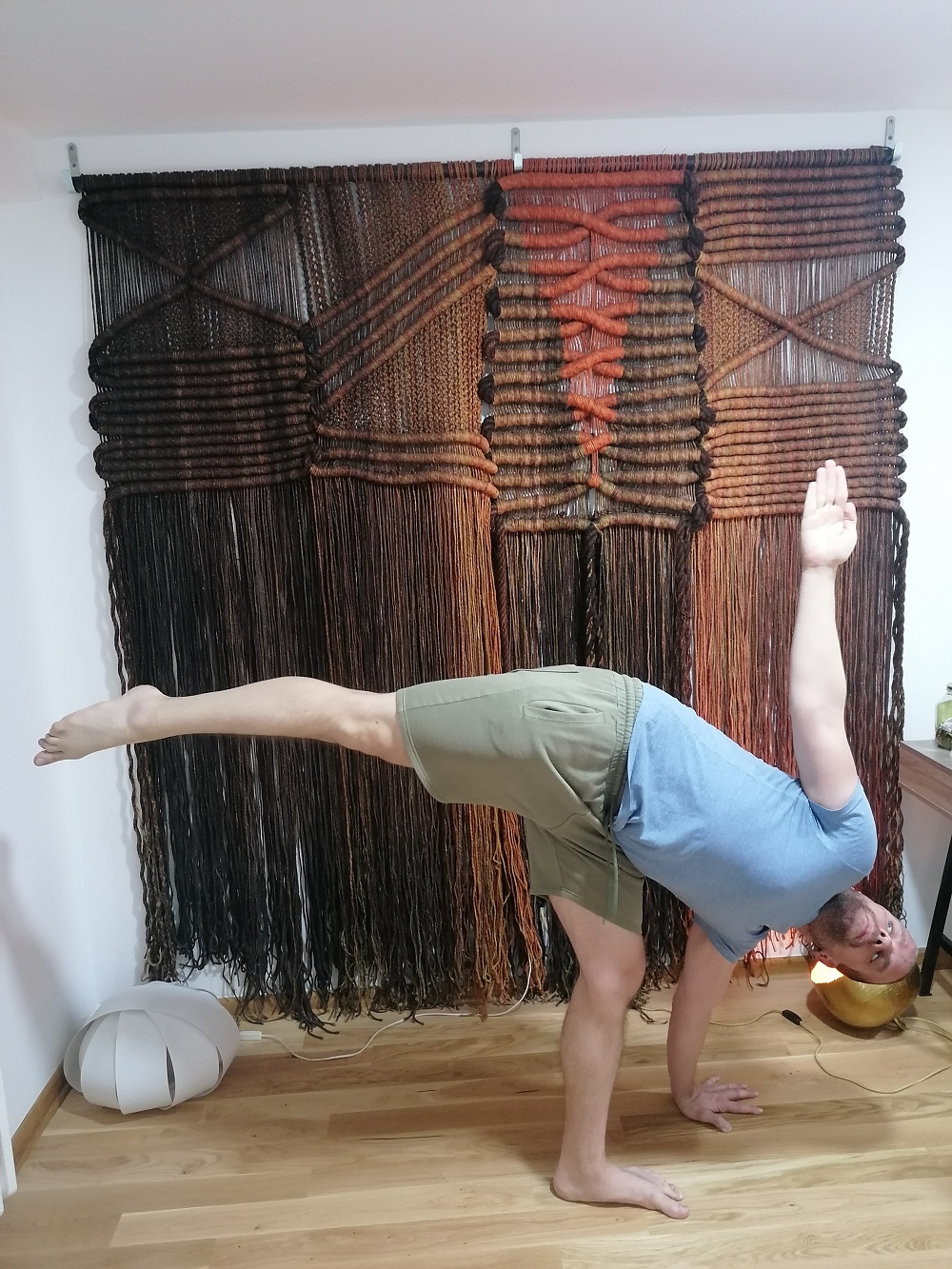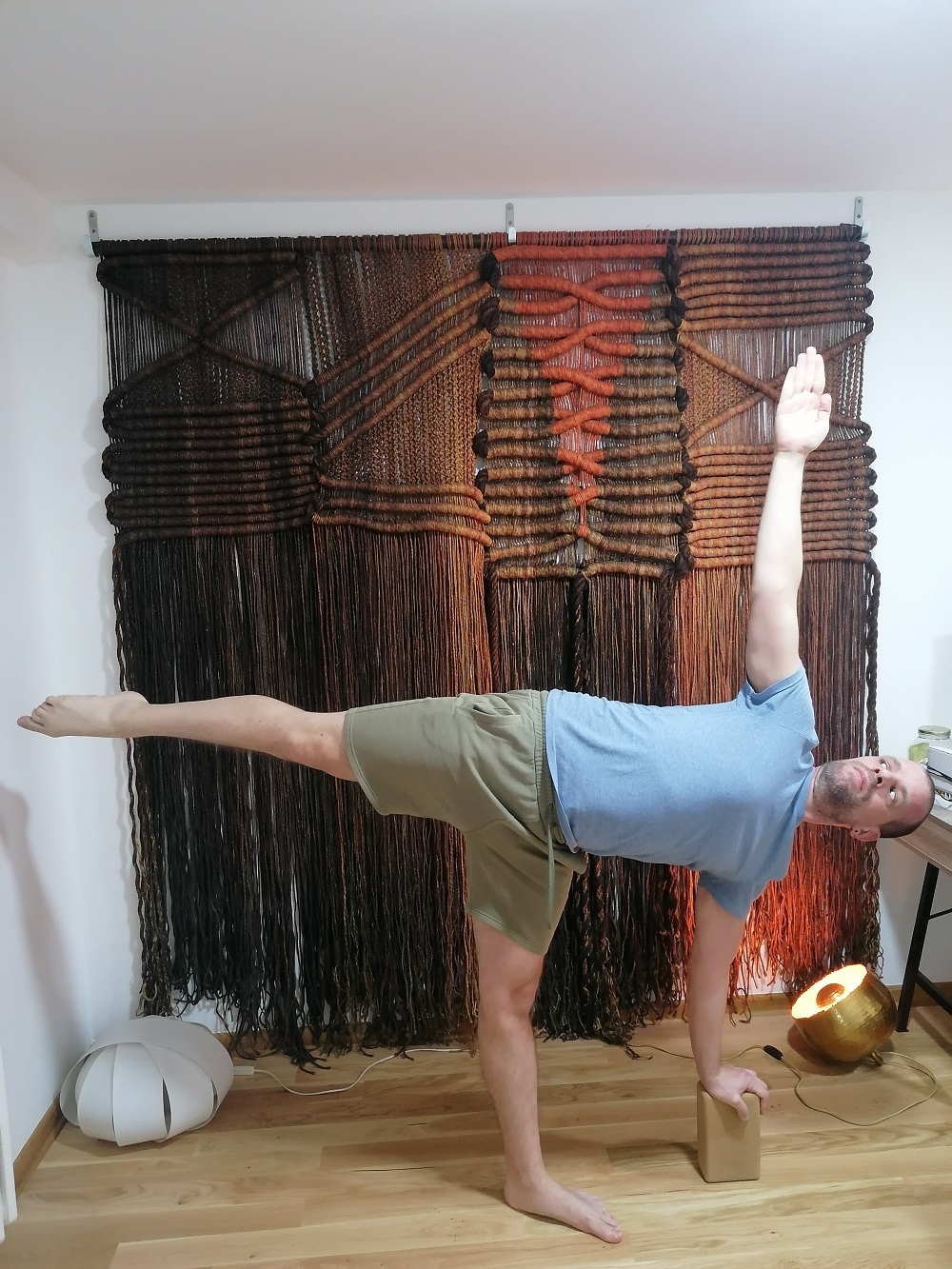This article is about the half-moon pose (Ardha Chandrasana). The pose itself is a demanding pose. If you want to practice this pose in a proper way, two things are essential: good balance on one leg and excellent focus. Consequently, we do not recommend this pose for practitioners who have not yet developed sufficient strength in their legs and who have not achieved a good focus while performing the mentioned balances. In the continuation of this article, we will highlight the poses that we recommend you to practice in order to successfully perform the half-moon pose.
Moreover, this pose is excellent for the proper functioning of the root (Muladhara) and sacral (Swadisthana) chakras. If you want to achieve a sense of security and connection with other people and all other beings, and if you want to activate your creative energy, start practicing the half moon pose right away.
PRACTICE AND BENEFITS
Practicing the half-moon pose develops the strength of your whole body. However, the focus is definitely on strengthening your feet, ankles, and legs. Strengthening your core while practicing half-moons should not be neglected. On the other hand, developing a better sense of balance and focus is a natural progression when practicing this pose.
Warrior 2 allows you to enter the pose itself. If your right leg is steady, in that case, you place your left hand on your left hip, fix your gaze on a point on the floor in front of your right foot. Let that point be at a distance of about a meter or a meter and a half from your body. Slowly lower your right hand to the floor on the outside of your right foot. The position of the palm itself largely depends on the proportions of your body. Some practitioners place their hand closer to their foot, while others place it further away. You can also use the block to your advantage.

If you are not using a block, you can place your entire palm or your fingertips on the floor. When lowering your hand, slowly lift your left leg. The left leg can be parallel to the floor or completely lifted up. If you don’t want to use blocks, try opening your left hip as far up as possible. It is also critical that your landing leg, which in this case is the right leg, is completely stable. You don’t have to completely straighten it at the knee; you can slightly bend it at the knee. In this way, you develop a better sense of balance, especially at the beginning of practicing this pose.
After leaning on the right palm or fingers and raising the left leg, it’s time to raise the left arm upwards. Try to keep both of your hands in the same line, with the upper hand stretched upwards as if you want to reach something within your reach with the fingers of the same hand.
When it comes to raising your left leg, raise it with complete awareness. If you raise it too much, it will throw you off the balance very easily. This pose is said to have the same significance as the tail in animals. The tail in animals is important for their sense of balance; therefore, while practicing this pose, please pay full attention to your “tail”. My advice is definitely to do leg lifts in stages. In the first phase, emphasize only the toes of the leg that will lift you. Your heel is raised while your toes are on the yoga mat. In the second phase, gently lift the toes from the yoga mat and lift the leg, trying to make it parallel to the floor at hip height. The third phase involves lifting your leg as high as possible, with the toes pointing upwards.
As far as gazing is concerned, keep your gaze focused on a point on the floor the entire time. Only when you enter the full pose should you try to direct your gaze to the fingers of the outstretched, raised hand. If you are stable in this pose and you want to work even more on focus and concentration, try closing your eyes while you are in this pose.
If you find the pose itself challenging at first, you can practice it with the help of a wall and a block. Both the wall and the block give you an added sense of security and stability. The wall also affects the hip opening of the lifted leg better. There is a better alignment of the entire body in the pose itself. While the wall serves as an additional support, you can also use a block at the same time. The block serves as a support for lowering your palm.

Of course, you can use the block completely independently of the wall. If you have already developed a certain sense of stability, the block is quite enough for you. Of course, the goal is to eventually be able to completely do the pose without any assistance. The distance between you and the wall represents your progress when performing this pose.
If the pose itself is a challenge for your current practice, we recommend the following poses which primarily strengthen your legs, core, and sense of balance. These poses are:
- Tree Pose
- Warrior 3
- Eagle Pose
- Chair Pose
- Boat Pose
We also advise you to practice Trataka if you have problems with focus. Unfortunately, most people today have trouble maintaining focus, so practicing Trataka is beneficial especially if you want to progress in your yoga practice and start practicing the upper balances.
CONCLUSION
If you recently had surgery or a knee injury, feel free to skip this pose, at least until your knee is ready for this type of pain.
Aids can be a wall or a block, but you can also use a chair as an aid. In this case, the chair replaces the block (the palm goes on the seat of the chair). However, you can combine a chair and a block (the foot of the raised leg goes on the seat or back of the chair, the palm on the block). But you can also combine a chair, a block, and a wall.
Since the half moon is a pose that engages your entire body, we advise you to try all the possible variations for this very reason. Allow your body to become aware of the pose itself through all these variations to enter it gradually. No rush, no strain. Do not hesitate to use all of the mentioned aids. It only helps you progress faster and more consciously when it comes to your yoga practice.







